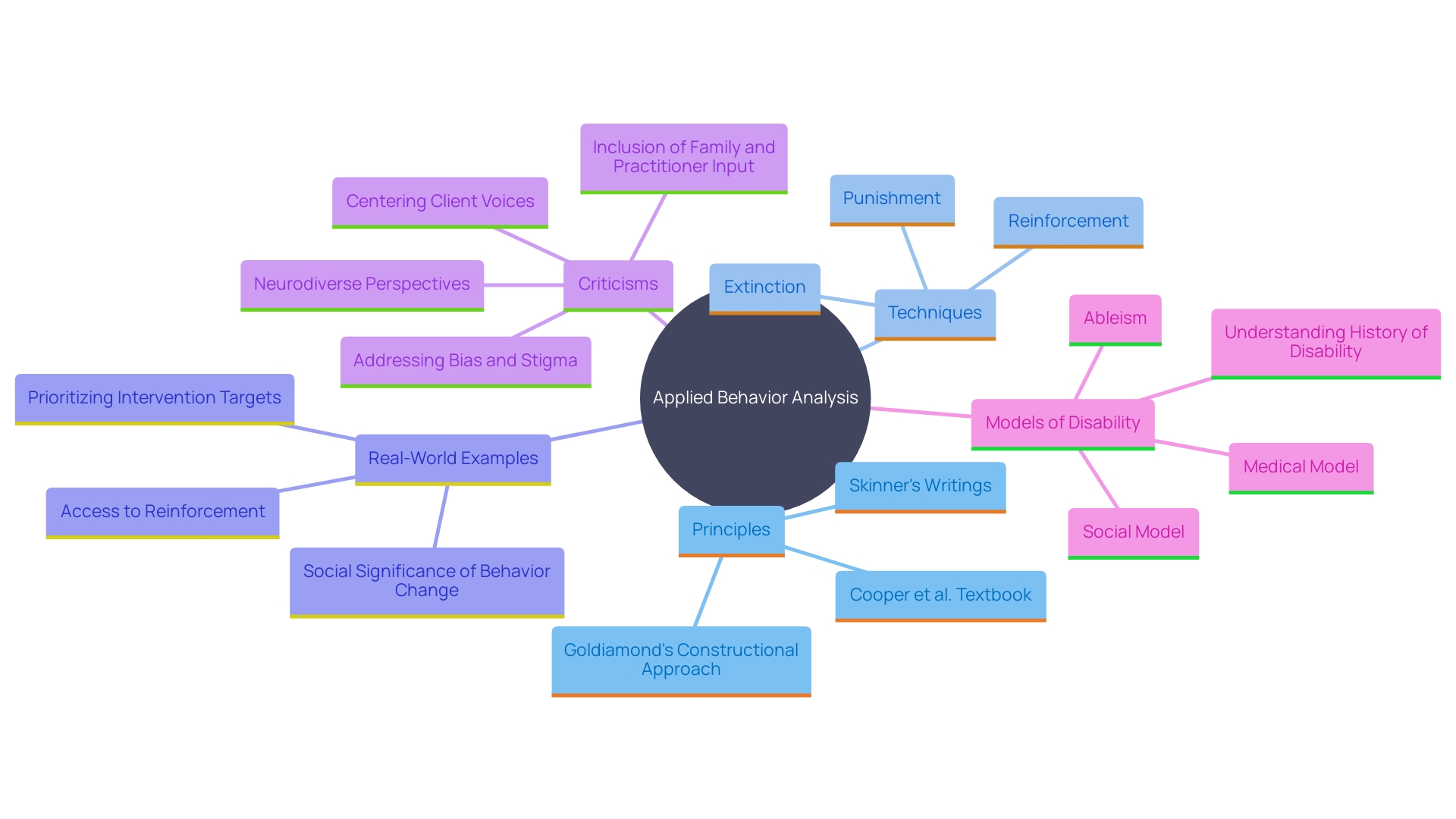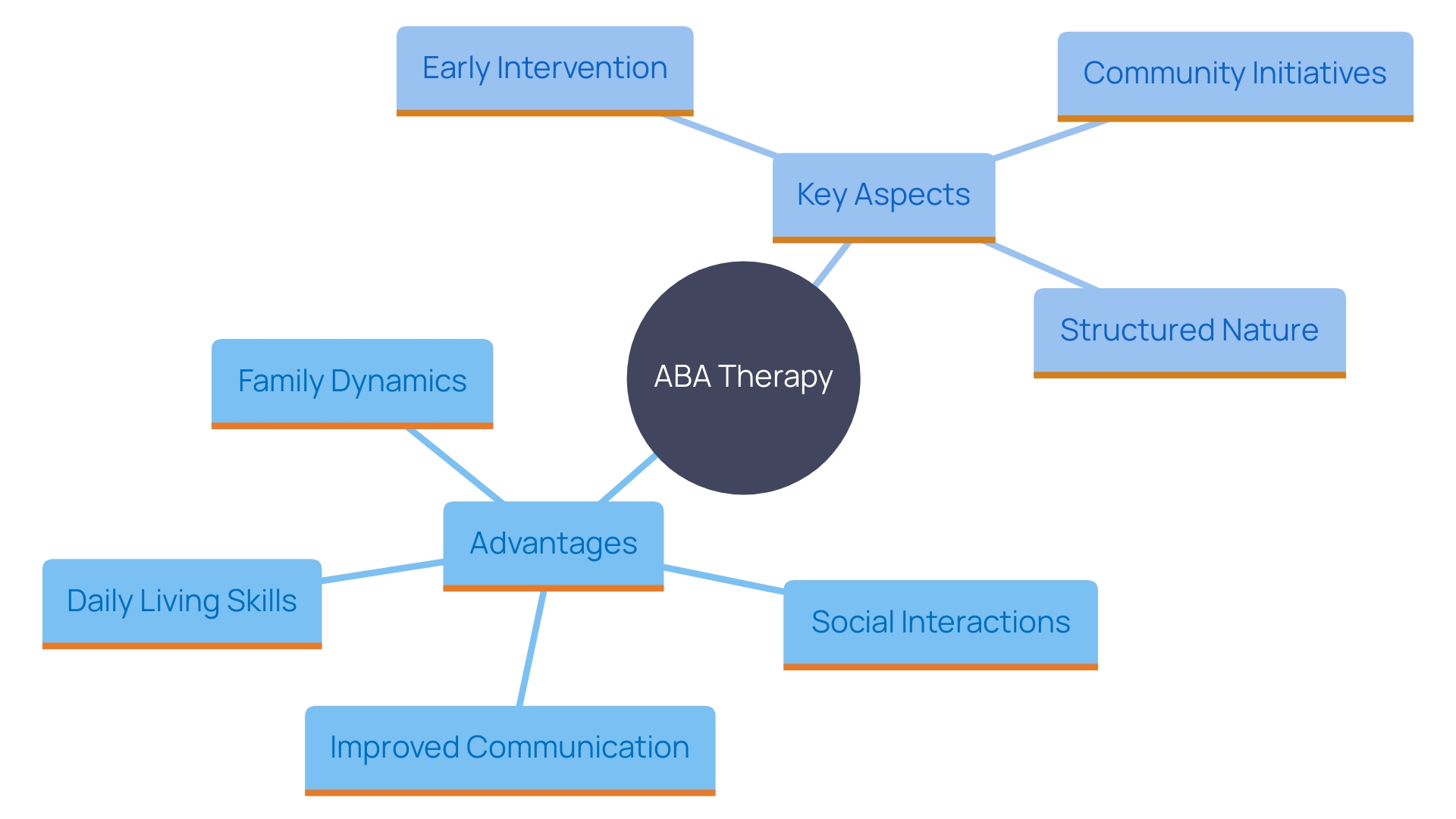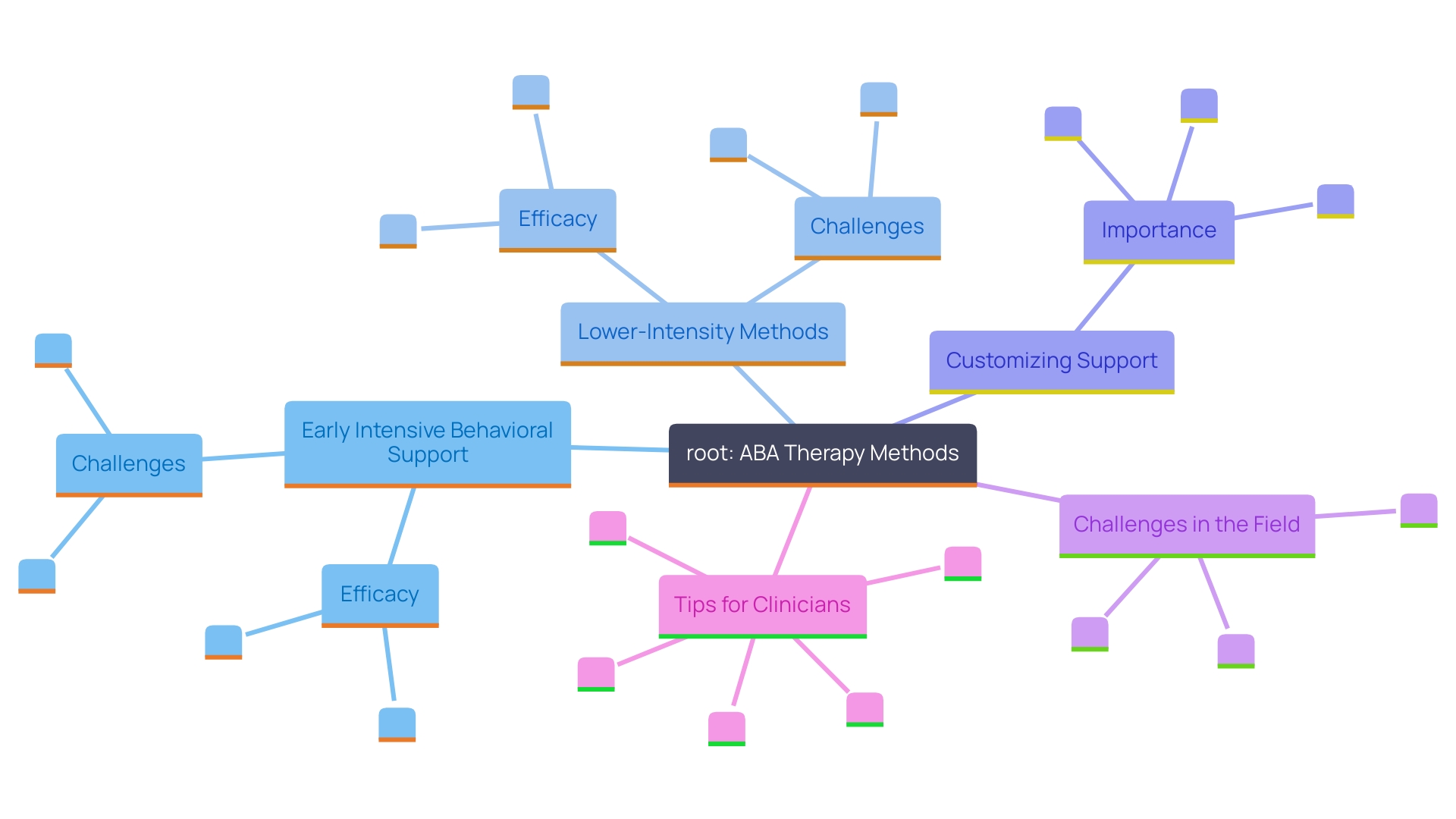Introduction
Applied Behavior Analysis (ABA) has revolutionized the way parents and professionals support children with autism and ADHD. Rooted in the principles of behaviorism, ABA focuses on how behaviors are learned and modified through environmental interactions. This article delves into the fundamental principles and techniques of ABA, highlighting real-world examples that demonstrate its transformative potential.
From reinforcing desired behaviors to addressing ethical considerations, the comprehensive overview emphasizes the importance of early intervention and evidence-based practices. While acknowledging criticisms and the need for ongoing refinement, the article underscores ABA's role as a powerful tool in promoting positive behavior changes and enhancing the quality of life for children and their families.
Principles of ABA
Applied Behavior Analysis (ABA) is rooted in behaviorism principles, focusing on how behaviors are learned and modified through environmental interactions. Key techniques include reinforcement, punishment, and extinction, which guide the development of effective interventions tailored to individual needs. Reinforcement, a core component, encourages desired behaviors by providing rewards, while punishment aims to reduce undesired behaviors. Extinction involves removing reinforcement to diminish unwanted behaviors.
For instance, in a case study involving a young individual named Lynn, extinction bursts were observed when new steps were introduced, leading to initial increases in severe behaviors. However, consistent application of extinction strategies reduced these behaviors over time. This showcases the importance of persistence and understanding in implementing ABA techniques effectively.
Real-world examples highlight ABA's impact. In Indiana, parents protested against reductions to therapy reimbursement rates, emphasizing ABA's vital role in their offspring's progress. Similarly, a Virginia press conference showcased a child who, thanks to ABA, overcame significant communication barriers. These stories underscore ABA's transformative potential.
Despite its benefits, ABA faces criticism and challenges. A meta-analysis by Michael Sandbank, PhD, revealed many low-quality studies affecting treatment recommendations, highlighting the need for better evidence and monitoring of potential adverse effects. The debate continues, with some clinicians advocating for more developmentally-informed, less intensive interventions.
In conclusion, ABA remains a powerful tool for promoting positive behavior changes, with ongoing discussions aimed at refining and improving its application to better serve individuals with developmental disorders and ADHD.

Benefits of ABA Therapy
'ABA therapy provides significant advantages, especially for young individuals with ADHD.'. It enhances communication, social interactions, and daily living skills, fostering greater independence and an improved quality of life. Parents often observe meaningful progress in their children's behavior and abilities, resulting in a more harmonious family dynamic. The structured, data-driven approach of ABA allows for continuous assessment and adjustment, ensuring ongoing improvement.
Data indicates that prompt actions greatly enhance social communication and tackle fundamental difficulties related to the condition. Programs like ABA, which incorporate techniques such as operant conditioning and target functional skills, have shown to be effective when implemented intensively, typically 20-40 hours per week. This rigorous approach aligns with best practices recommended by experts.
The significance of early action cannot be overstated. As stated by the National Institute for Health and Care Excellence, strategies such as pediatric communication therapy and JASPER are essential for tackling early social interaction in natural environments. Such tailored approaches, supported by substantial evidence, are crucial for long-term positive outcomes.
Furthermore, the joint initiatives of federal advisory committees such as the IACC highlight the importance of coordinated, community-oriented approaches to expedite advancements in research and services related to neurodevelopmental disorders. These committees bring together a diverse group of stakeholders, including researchers, providers, and family members, to enhance the quality of care and support available to families.
Statistics from recent studies further illustrate the effectiveness of ABA therapy. Data analysis demonstrates substantial enhancement in social validity, feasibility, and acceptability, with comprehensive cost assessments backing the economic feasibility of these approaches. These findings highlight the significance of early, intense, and closely supervised measures for children with developmental disorders and ADHD.

Ethical Considerations in ABA Practice
Ethical considerations are fundamental in ABA practice, with practitioners always prioritizing the dignity and well-being of individuals receiving therapy. Informed consent and confidentiality are paramount, ensuring that the rights of clients are always respected. Moreover, ABA professionals are committed to using evidence-based practices and avoiding any form of coercion or manipulation. By cultivating a cooperative atmosphere where families engage in the decision-making process, trust is established, and actions are more closely aligned with the values and objectives of the individual. Emphasizing shared decision-making is particularly important, as it ensures that the voices of clients, their families, and other stakeholders are all heard and respected. This approach not only addresses common criticisms of ABA but also paves the way for a more inclusive and effective practice. As Zoe Gross, director of advocacy at the Autistic Self Advocacy Network, mentioned, “These guidelines don’t change our fundamental concerns about the philosophy behind ABA, the evidence base for ABA, how it is practiced and its effect on autistic people.” However, with a strong emphasis on shared decision-making and collaboration, the field can move towards a more ethical and client-centered practice.
Evidence-Based Practice in ABA
ABA therapy, short for Applied Behavior Analysis, is widely acknowledged as an evidence-based practice, backed by extensive research demonstrating its efficacy. Thorough research consistently demonstrates that ABA methods can result in significant advancements in behavior and skill development among individuals with developmental disorders. The careful use of data gathering and analysis enables practitioners to assess progress precisely and make informed changes to strategies.
In the United States, early intensive behavioral support, a type of ABA, is regarded as the gold standard for early care of individuals with developmental disorders. This highly structured, one-on-one support is typically provided for 20-40 hours per week. Despite its intensity, this approach has been shown to effectively target functional skills and promote positive long-term outcomes.
However, the environment of support strategies for individuals on the spectrum is not without its challenges. Research led by experts like Michael Sandbank, PhD, highlights the prevalence of low-quality studies that dominate the field, which can complicate clinical practices and patient outcomes. 'Sandbank's meta-analysis, published in the British Medical Journal, emphasizes that while many approaches show potential benefits, there is also a need for better monitoring and reporting to avoid potential adverse effects.'.
Unlike the intensive method in the U.S., the National Institute for Health and Care Excellence in England endorses lower-intensity methods such as pediatric autism communication therapy and JASPER, which emphasize early social communication during natural interactions. These varying recommendations highlight the importance of customizing assistance to the unique needs of each individual, ensuring that the support provided is effective and responsive to their specific requirements.

Common Applications of ABA
ABA therapy is utilized in various environments, such as homes, schools, and clinics, making it a versatile approach for addressing a wide range of needs. It is particularly effective in managing challenging behaviors, enhancing social skills, and improving communication abilities. One of the primary uses of ABA is in early intervention programs for young individuals, where it plays an essential role in fostering skill development and favorable long-term results. In educational settings, ABA provides behavioral support that facilitates learning and social interactions. Furthermore, it provides techniques for handling everyday schedules and changes, which can be especially helpful for individuals with developmental differences.
The adaptability of ABA allows it to be tailored to the unique challenges faced by each individual, making it a valuable tool for both parents and educators. For instance, the Early Start Denver Model, which is an ABA-based approach, is designed for individuals aged 12-48 months and focuses on improving language, social, and learning skills through play and social exchanges. This model highlights the importance of natural interactions and shared attention in fostering development.
Furthermore, ABA's organized strategies are extensively utilized in community-based services for individuals on the spectrum, which support over 50,000 autistic persons and create substantial income. Despite the growth in these services, there is a need for more research to ensure their effectiveness and quality, especially for underrepresented groups. Systematic reviews and meta-analyses have demonstrated positive effects of both highly-structured ABA interventions and naturalistic developmental behavioral interventions on developmental outcomes for young individuals with developmental disorders.
In conclusion, the effectiveness and flexibility of ABA therapy make it an indispensable resource for supporting the development and well-being of individuals with autism and ADHD. By utilizing its principles and techniques, parents and professionals can establish nurturing and empowering settings that address the particular requirements of each individual.
Controversies and Criticisms of ABA
While ABA therapy is widely endorsed by many parents and practitioners, it has not been without its set of criticisms and controversies. Some argue that certain techniques, particularly those involving aversive measures, can be harmful. Additionally, concerns have been raised about the reliance on external rewards potentially diminishing intrinsic motivation. It's essential for practitioners to remain aware of these criticisms and strive for compassionate, ethical practices that prioritize positive outcomes.
Engaging in open dialogue with families and the community can help address these concerns and promote a more nuanced understanding of ABA. By openly acknowledging and addressing the criticisms against ABA, we can take practical steps toward a profession and a society that more fully embraces inclusion. The ethical imperative of centering autistic voices does not entail excluding other voices; instead, it includes considering perspectives from families, teachers, and clinicians, which are both expected and valuable.
Moreover, it's imperative to hold those involved in the creation and propagation of treatments to a higher standard of methodological rigor. Insisting on greater transparency and humility from researchers and guarding against the urge to adopt new approaches without high-quality evidence is crucial. For instance, a comprehensive meta-analysis of 252 studies of non-pharmacological interventions for young individuals with autism highlights common sources of bias, emphasizing the need for rigorous evaluation.
In recent years, there have been positive stories showcasing the benefits of ABA when implemented effectively. For example, in Virginia, a child once unable to speak was able to lead a public event due to the positive impact of ABA therapy. However, ongoing scrutiny and adaptation of practices are necessary to ensure that ABA remains a beneficial and ethical option for those who need it.
Conclusion
The exploration of Applied Behavior Analysis (ABA) reveals its profound impact on the lives of children with autism and ADHD. Through principles rooted in behaviorism, ABA effectively modifies behaviors by leveraging reinforcement, punishment, and extinction techniques. Real-world examples illustrate the transformative potential of ABA, with parents and professionals witnessing significant improvements in communication and social skills, ultimately leading to enhanced independence and quality of life.
The importance of early intervention cannot be overstated, as evidence suggests that timely and intensive ABA therapy can yield remarkable outcomes. Collaborative efforts among stakeholders, including federal advisory committees, emphasize the need for community-based strategies that support families and promote best practices. However, the field must also address ethical considerations, ensuring that the dignity and rights of individuals receiving therapy are prioritized.
A commitment to shared decision-making fosters trust and aligns interventions with the values of those involved.
While ABA therapy faces scrutiny and calls for refinement, its evidence-based foundation remains a cornerstone of effective practice. By acknowledging both the strengths and criticisms of ABA, practitioners can work towards a more inclusive and client-centered approach. Ultimately, the ongoing dialogue surrounding ABA serves as a catalyst for improvement, ensuring that it continues to be a valuable tool in supporting the development and well-being of children with autism and ADHD.




